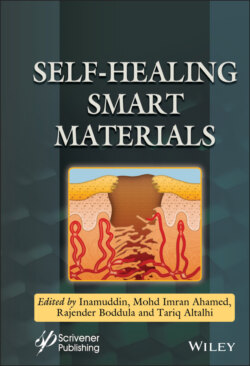Читать книгу Self-Healing Smart Materials - Группа авторов - Страница 39
3.3.4 Bromobutyl Rubber
ОглавлениеThe principal characteristics of bromobutyl rubber (BIIR) are its high air impermeability and resistance to chemical agents. BIIR is obtained from bromination of butadiene rubber, enhancing the reactivity with amines and, therefore, allowing various functionalities to BIIR.
The above mentioned mechanism was used by Das et al. to introduce ionic functional groups in a rubber compound by using butylimidazole to increases the ionic interaction with the aim to enhance the self-healing, without no extra cross-links agent required [55]. Authors compounded BIIR and butylimidazole in an internal mixer to form amidazolium bromide groups (Figure 3.17), previously an isomerization of the bromide group is induced to obtain the reactive species. Then, the elastomer network is produced by ionic crosslinking and the obtained samples are soluble, which can be seen as an advantage from the environmental point of view. The crosslinking reaction was characterized in a rheometer at temperatures between 80 and 160 °C during 1 h. The highest modulus values were obtained at 100 °C, and it was found that at higher temperatures the modulus decreases, indicating the weakness of the ionic interactions at elevated temperatures. The self-healing behavior was observed through stress–strain measurements on cut samples, which were allowed to heal at different times: at room temperature during 1, 10, 24, 96 and 196 h and to explore a faster healing the cut and restored sample was maintained at 100 °C for the first 10 min of the total time. It was found that the healing effect increases with time and the obtained stress–strain curves are similar to that one from the uncut sample, as can be seen in Figure 3.18. A good self-healing is obtained due to the reversible characteristic of the ionic bonds and to the good mobility of the isobutylene chains (which is improved at higher temperatures). They did not obtain self-healing in the compound crosslinked with sulfur.
Figure 3.17 Reaction scheme for the conversion of BIIR with butylimidazole for posterior self-healing by ionic cross-linking (Adapted with permission from Das et al. [55]).
Figure 3.18 Stress–strain measurements to characterize self-healing behavior in BIIR samples modified with imidazolium (BIIR-i) when the healing was made at room temperature at different length times (blue lines) and when the first 10 minutes of heal was made at 100 °C (red lines), compared with an uncut sample (black line) (Adapted with permission from Das et al. [55]).
Lee and coworkers evaluated the self-healing property in pristine BIIR when is used as a coating to prevent corrosion, demonstrating that the healing process is highly stimulated by temperature by using a copper nanofiber as heater [56]. Kim et al. proposed a bilayer of BIIR over another one of BIIR with carbon nanotubes (in a concentration between 7 and 10 wt.%). The latter was used as heater to improve the self-healing efficiency [57]. The bi-layer was prepared through different methods: casting, painting and spraying. The angle between the applied current and the performed linear crack was varied (0, 45 and 90°) in order to study the influence of the current direction in the self-healing process. In the case of a current parallel to the crack orientation, the healing process took 2.5 h, while in the case that the current and the crack direction are parallel just 1 h is required. Then a repeating healing was performed, founding that up to a third cycle the material self-healed successfully when the sample is heated during 1 h in each cycle, as can be seen in Figure 3.19. Finally, they performed corrosion tests by applying the bi-layer in a steel substrate. To this aim, a deep scratch was made in 2 samples which were submerged in saline water and only one of the samples was heated during 1 h. After 72 h under the saline bath, the bi-layer was removed from the samples and the steel surface was observed, founding rust in the sample that was not heated (Figure 3.20).
Figure 3.19 Bi-layer of BIIR and BIIR-CNT. Repeated healing test under water, the electrical current is perpendicular to the crack direction and is applied during 1 h in each cycle (Reprinted with permission from Kim et al. [57]).
Figure 3.20 Bi-layer of BIIR and BIIR-CNT in a steel substrate to evaluate corrosion test in saline water during 72 h. (a) without heating, (b) with heating (Reprinted with permission from Kim et al. [57]).
